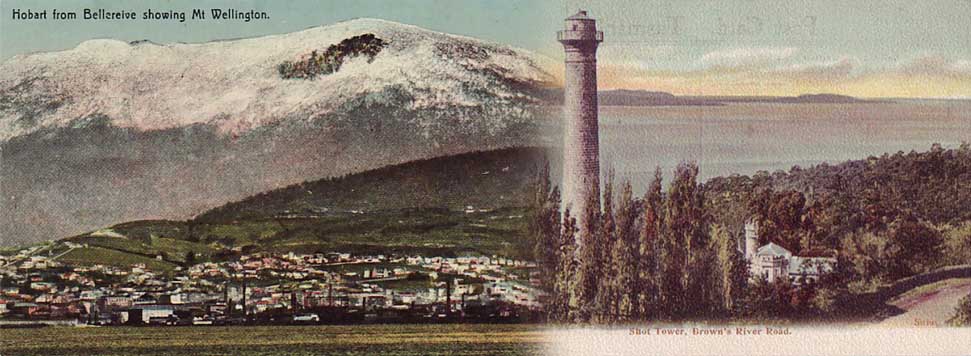Selwyn Cox (1871-1941)
.jpg) Selwyn Cox was a stationer and postcard publisher in Launceston. His obituary in the Launceston Examiner of 3 Dec 1941 gave an overview of his life:
Selwyn Cox was a stationer and postcard publisher in Launceston. His obituary in the Launceston Examiner of 3 Dec 1941 gave an overview of his life:
"The death occurred at his residence, Trevallyn, yesterday, of Mr. Selwyn Cox, for many years a businessman in Launceston. Mr. Cox was born 71 years ago in Horsley, Gloucestershire, England, and was a son of Mr. and Mrs. J.C. Cox. He was educated at the Amberley Church Grammar School and later at the St. Chloe’s Grammar School. He was apprenticed to W. Brown and Co., stationers, of London for a time.
"Mr. Cox came to Tasmania in 1891at the age of 21 and was employed in the wholesale warehouse of Godgshun and Co. until 1895, when he entered the services of Richard Gee as manager of his stationery department. He remained there for 10 years and then opened his own stationery business in Charles Street. He retired only a few months ago.
"Mr Cox had many outside interests. He was a keen churchman, first at St. John’s Church of England, where he was secretary of the executive committee of the extension building movement for about 14 years. He was also on the first Church Parish Council. When the St. Oswald’s Church, Trevallyn, was built, he became the superintendent of the Sunday school and a trustee of the church.
"He was the first secretary and one of the prime movers in the formation of Launceston Y.M.C.A., of which he later became president and trustee. He was also the first secretary and one of the original members of the Union Jack Gymnasium Society, and was elected a life member. For many years he was secretary of the Trevallyn Improvement Association. He was a member of the Parliamentary Debating Society. A short while after he came from England he won the Burnie Gift.
"Mr Cox had a great interest in Masonic work, being a member of the Lodge of Hope. He was master of the lodge in 1918.
"He is survived by his wife, six children (five daughters and one son) and a brother. The funeral will be private.
Selwyn Cox was a stationer, operating from a shop at 96 Charles Street, Launceston from 1905 until his retirement in 1941, a few months before he died. He sold a full range of stationery and associated items, as shown in his advertisement for Christmas of 1906 shown at left.
Cox published his own postcards in the early years of his business, from 1905 up to about 1910. In 1905 and 1906 he advertised the “Beautiful Tasmania” series. In 1905 to 1907 his advertisements mentioned his Wynphotoprint series of b&w cards. The bulk of his postcard sales were probably imported British cards, with the Tasmanian scene cards being only a small component of his sales. In 1909 he was advertising "Postcards of Tasmanian Scenery" and in 1910 "Postcards of local scenes", but after that there were no advertisments of postcards, either of his own productions or of imported British cards. After 1910 he advertised postcard albums and postcard frames, but not postcards themselves, although he no doubt continued to sell imported cards.
Selwyn Cox was not a photographer, and used images supplied by other photographers on his postcards. Exactly who those photographers were is not known, as he did not credit the photographers on his cards. Neither did he credit the printer of his cards. His b&w cards were printed by collotype, by Stengel & Co, Dresden, Germany, who was the largest German printer of the time. Three characters of the cards indicate Stengel as the printer: the style of the caption, the layout of the back, and the presence of "hidden numbers", small script numbers withing the image. His coloured cards were printed by collotype and photolithography, also by Stengel & Co. The production process involved Cox supplying a b&w photographic print, or a glass plate negative, to the printer, along with a specification of the layout required on the front and back of the card. The printer in Germany hand-coloured the photograph, using colours specified in writing by Cox, or if that was not provided, using colours decided by the printer's colourist. The printer then printed the cards in the quantity ordered, and dispatched them on the six week trip back to Tasmania.
In 1910 and 1911 Cox appears to have been the force behind the Pictorial Postcard Co. This company operated from a different address from his shop at 96 Charles Street, but the similarity of its cards to the Selwyn Cox products suggests that it was a branch of his business. When it started up in 1910 it advertised “To the trade, large and small wholesale buyers”, offering postcards as well as general stationery, suggesting that it was his wholesale outlet. This venture did not last long, advertising a “Great Selling off Sale” in 1911.
